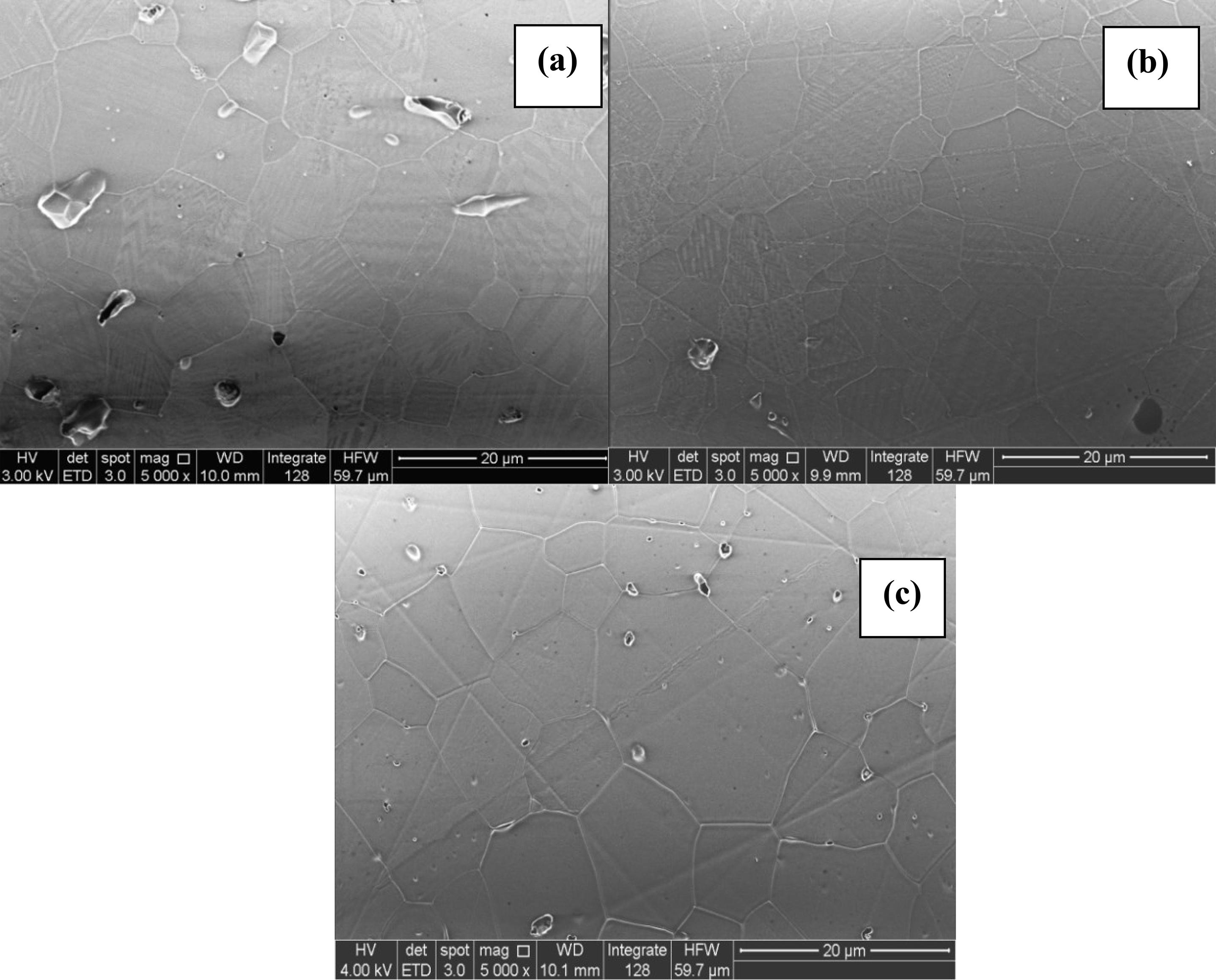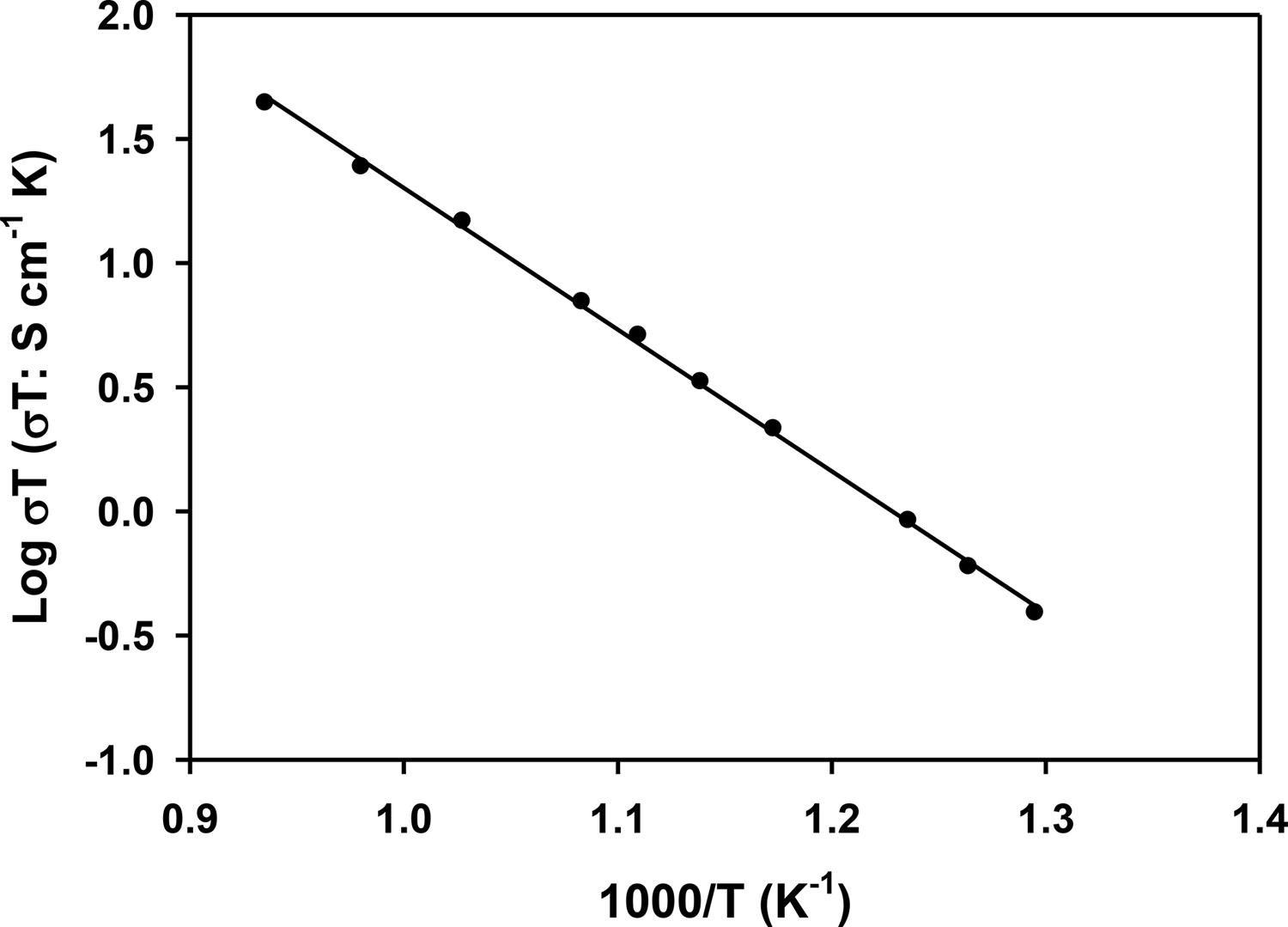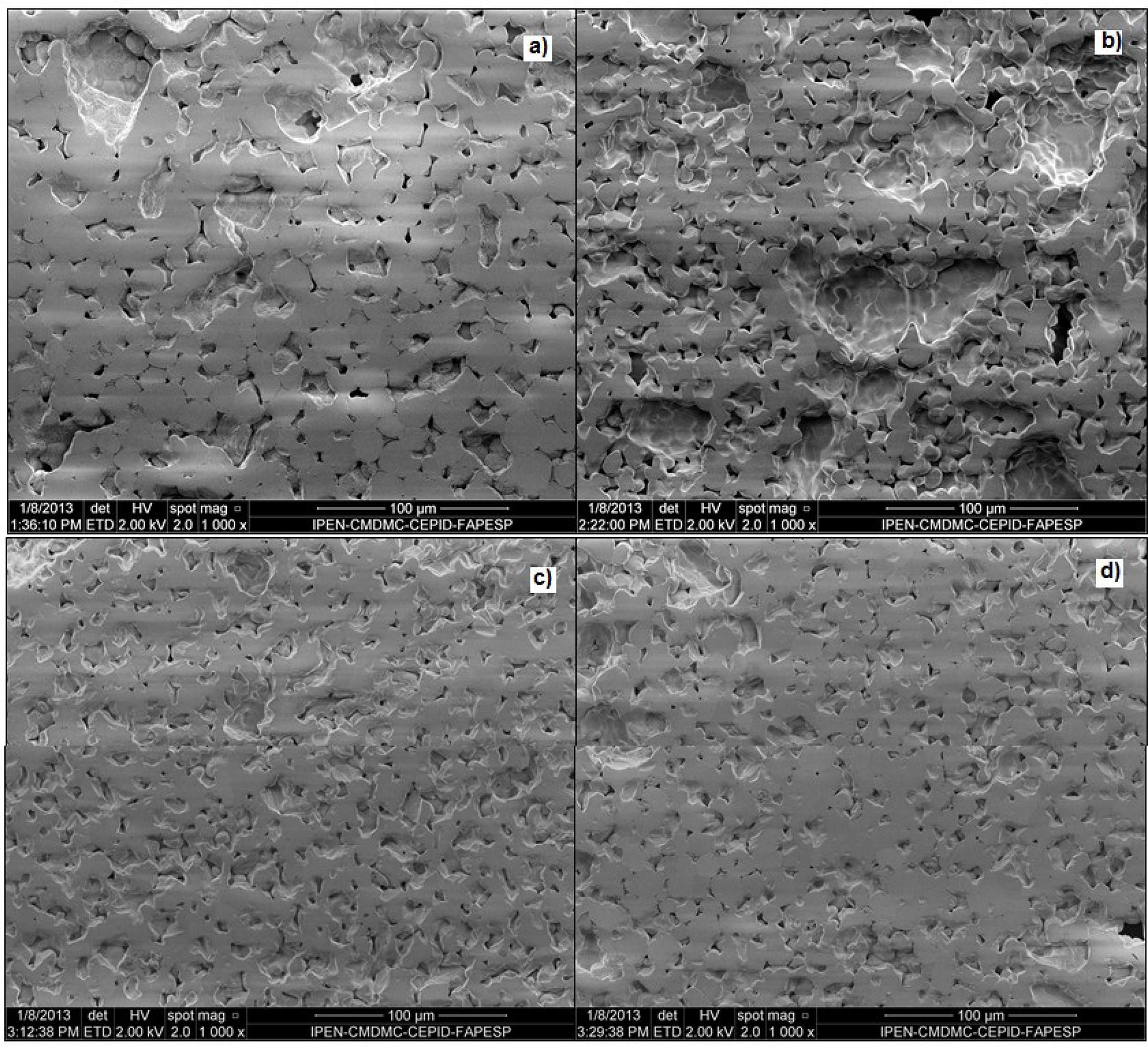ABSTRACT
The effects of small additions of tin, zinc, calcium and boron oxides on phase composition and electrical conductivity of zirconia-10 mol% scandia were investigated. Compounds containing 1 mol% zinc, tin and calcium oxides and 1, 3 and 5 wt.% boron oxide were prepared by solid state reaction and characterized by X-ray diffraction, density measurements, scanning electron microscopy and impedance spectroscopy. Full stabilization of the cubic structure at room temperature was obtained with additions of 1 mol% calcium oxide and 2 wt.% boron oxide. Partially stabilized compounds exhibit herringbone structure, characteristic of the β-rhombohedric phase. Specimens with calcium as additive show total conductivity of 23.8 mS.cm-1 at 750ºC with activation energy of 1.13 eV. Liquid phase sintering by boron oxide addition is effective to enhance the densification of the solid electrolyte.
scandia-doped zirconia; phase stabilizer; sintering aid; ionic conductivity
1. INTRODUCTION
The combination of high ionic conductivity, wide electrolytic domain and low electronic conductivity turns the scandia stabilized zirconia, ScSZ, solid electrolyte a promising candidate for replacing yttria stabilized zirconia for application in solid oxide fuel cells operating at intermediate temperatures, typically 800ºC [1[[1] HAGENMULLER, P., VAN GOOL, W., Solid Electrolytes-general principles, characterization, materials, applications, New York, Academic Press, 1978.
[2] SUBBARAO, E. C., Solid Electrolytes and their applications, New York, Plenum, 1980.-3[3] BADWAL, S. P. S., CHIACHI, F. T., MILOSEVIC, D., “Scandia-zirconia electrolytes for intermediate temperature solid oxide fuel cell operation”, Solid State Ionics, v. 136-137, PP. 91-99, 2000.]. The higher ionic conductivity of ScSZ is found for scandia contents of 8-10 mol% [3[3] BADWAL, S. P. S., CHIACHI, F. T., MILOSEVIC, D., “Scandia-zirconia electrolytes for intermediate temperature solid oxide fuel cell operation”, Solid State Ionics, v. 136-137, PP. 91-99, 2000.]. Nevertheless, the phase diagram of this solid electrolyte reveals a thermal degradation of the cubic phase for scandia contents up to 9-10 mol% giving rise to the tetragonal polymorph. Moreover, for higher scandium contents, the cubic to b-rhombohedric phase transition readily occurs. Both, tetragonal and rhombohedric phases exhibit lower ionic conductivity than that of the high symmetry cubic structure [2[2] SUBBARAO, E. C., Solid Electrolytes and their applications, New York, Plenum, 1980.,3[3] BADWAL, S. P. S., CHIACHI, F. T., MILOSEVIC, D., “Scandia-zirconia electrolytes for intermediate temperature solid oxide fuel cell operation”, Solid State Ionics, v. 136-137, PP. 91-99, 2000.].
Then, up to date, one of the main goals has been to stabilize the cubic phase at room temperature. One approach to accomplish that is by the introduction of a second additive. In this context, continuing efforts have been made to find a suitable additive allowing for phase stabilization without excessive deterioration of the ionic conductivity. The additives investigated include those oxides with relatively high solubility such as rare earths [4[4] YAMAMOTO, O., ARATI, Y., TAKEDA, Y., et al., “Electrical conductivity of stabilized zirconia with ytterbia and scandia”, Solid State Ionics, v. 79, pp. 137-142, 1995.
[5] POLITOVA, T., I., IRVINE, J. T. D., “Investigation of scandia-yttria-zirconia system as an electrolyte material for intermediate temperature fuel cells-influence of yttria content in the (Y2O3)x((Sc2O3)(11-x)(ZrO2)8.9”, Solid State Ionics, v., 168, pp. 153-165, 2004.
[6] LEE, D.S., KIM, W. S., CHOI, S. H., et al., “Characterization of ZrO2 co-doped with Sc2O3 and CeO2 electrolyte for the application of intermediate temperature SOFCs”, Solid State Ionics, v. 176, pp. 33-39, 2005.
[7] ABBAS, H. A., ARGIRUSIS, C., KILO, M., et al., “Preparation and conductivity of ternary scandia-stabilised zirconia”, Solid State Ionics, v. 184, pp. 6-9, 2011.-8[8] GROSSO, R. L., MATOS, J. R., MUCCILLO, E. N. S., “Thermal and spectroscopic characterization of nanostructured zirconia-scandia-dysprosia”, J. Therm. Anal. Calorim., v. 117, pp. 567-572, 2014.] and other oxides [9[9] VARANASI, C., JUNEJA, C., CHEN, C., et al., “Electrical conductivity enhancement in heterogeneously doped scandia-stabilised zirconia”, J. Power Sources, v. 147, pp.128-135, 2005.
[10] OMAR, S., NAJIB, W. B., CHEN., et al., “Electrical conductivity of 10 mol% Sc2O3-1 mol% M2O3-ZrO2 ceramics”, J. Am. Ceram. Soc., v. 95, pp. 1965-1972, 2012.
[11] GROSSO, R. L., MUCCILLO, R., MUCCILLO, E. N. S., “Stabilization of the cubic phase in zirconia-scandia by niobium oxide addition”, Mater. Lett., v. 134, pp. 27-29, 2014.-12[12] STANDAR, O. C., SORREL, C. C., “Densification of zirconia - conventional methods”, Key Eng. Mater., v. 153-154, pp. 251-300, 1998.].
So far, the higher ionic conductivity, amounting ~ 18 mS.cm-1 at 600ºC, was found for the system zirconia-10 mol% scandia-1 mol% ceria [10[10] OMAR, S., NAJIB, W. B., CHEN., et al., “Electrical conductivity of 10 mol% Sc2O3-1 mol% M2O3-ZrO2 ceramics”, J. Am. Ceram. Soc., v. 95, pp. 1965-1972, 2012.]. However, it was found that the cubic phase transforms on the surface of the solid electrolyte to monoclinic via tetragonal phase during operation at 900ºC of a tubular-type SOFC [13[13] SHIMAZU, M., ISOBE, T., ANDO, S., et al., “Stability of Sc2O3 and CeO2 co-doped ZrO2 electrolyte during operation of solid oxide fuel cells”, Solid State Ionics, v. 182, pp. 120-126, 2011.]. Conductivity degradation of this electrolyte was also observed at 600ºC during long-term operation in humidified mixture of H2/N2 and humidified H2 [14[14] OMAR, S., BELDA, A., ESCARDINO, A., et al., “Ionic conductivity ageing investigation of 1Ce10ScSZ in different partial pressures of oxygen”, Solid State Ionics, v. 184, pp. 2-5, 2011.].
In this work, small amounts of tin, zinc and calcium oxides as phase stabilizer, and boron oxide as sintering aid were added to zirconia-10 mol% scandia and their effects on structure, microstructure and ionic conductivity were investigated.
2. MATERIALS AND METHODS
2.1 MATERIALS PREPARATION
Zirconia-10 mol% scandia, ScSZ (Daiichi Kigenso Kagaku Kogyo, Japan), SnO (Alfa Aesar, 99.9%), CaCO3 (Vetec, 99%), zinc stearate (Zn(C18H35O2)2) and boron oxide (B2O3, Alfa Aesar 99.9%) were the starting materials. The investigated composition was ZrO2-10 mol% Sc2O3-1 mol% A (A=Zn, Sn, Ca) and 1, 3 and 5 wt.% B2O3.
The starting materials were weighted in the stoichiometric proportion and mixed together in alcoholic medium followed by drying at 40ºC for 1 h. Cylindrical specimens were prepared by uniaxial (50 MPa) followed by isostatic (100 MPa) pressing. The sintering of the green compacts was carried out at 1500ºC for 5 h in a resistive furnace (Lindberg BlueM, 51524) with heating and cooling rates of 5 and 30 ºC.min-1, respectively. Specimens containing calcium and zinc were first heated up to 800ºC for 1 h for precursor decomposition. Specimens with boron oxide addition were sintered at 1500oC for 4 h. Sintered specimens are named 10Sc1ASZ standing for zirconia-10 mol% scandia-x mol% additive. The experimental procedure for boron oxide was similar to that of other additives. In this case the prepared compositions were zirconia-10 mol% scandia-y wt.% B2O3 with y=1, 2, 3 and 5.
2.2 Characterization methods
The apparent density of sintered specimens was determined by measuring sample dimensions and mass and compared to the theoretical value calculated from the lattice parameters of the several compositions. Phase characterization was performed by room temperature X-ray diffraction, XRD (Bruker-AXS, D8 Advance) in the 20-80º 2q range with Ni filtered Cu Kα radiation (l=1.5405 Å). Indexing of diffraction profiles was performed by comparison of XRD patterns with those of JCPDF 89-5483 and 511604 files for cubic and rhombohedric phases, respectively. The microstructure of sintered specimens was observed by field emission scanning electron microscopy, FEG-SEM (FEI, Inspect F50) on polished and thermally etched surfaces. The ionic conductivity was measured by two-probe electrochemical impedance spectroscopy (HP4192A), with 100 mV of applied signal in the 13 MHz-5 Hz frequency range. Silver and platinum were used as electrode materials for electrical measurements in the low (< 600ºC) and high (3 600ºC) temperature ranges, respectively. Special software was used for data collecting and analysis [15[15] KLEITZ, M., KENNEDY, J. H., “Resolution of multi-components components impedance diagram”, In: Vashishta, P., Mundy, J. N., Shenoy, G. K. (eds), Fast Ion Transport in Solids, Electrodes and Electrolytes, p.185-188, North-Holland, Amsterdam, 1979.].
3. RESULTS AND DISCUSSION
3.1 Zirconia-10 mol% scandia-1 mol% SnO2, ZnO and CaO
Figure 1a shows XRD patterns of zirconia-10 mol% scandia-1 mol% A (A=SnO2, ZnO, CaO) specimens sintered at 1500ºC for 5 h. Addition of calcium promoted fully stabilization of the cubic phase at room temperature. Specimens containing zinc oxide exhibit only reflections of the rhombohedric phase, whereas partial stabilization of the cubic structure is found for tin oxide addition. The angular region of 2q between 48 and 53º is highlighted in Fig. 1b evidencing the phase composition for these specimens.
: XRD patterns of ZrO2: 10 mol% Sc2O3-1 mol% A (A=SnO2, ZnO, CaO) specimens sintered at 1500°C for 5 h, in the (a) 20-80° and (b) 48-53° 2q ranges; c and β stand for the cubic and rhombohedric phases, respectively.
Table 1 lists values of relative density (in %) and phase composition (c=cubic, b=rhombohedric) of sintered specimens. It is remarkable the effect of the additive on microstructure. Zinc oxide does not promote phase stabilization and decreases the sintered density. Addition of calcium oxide is effective for the cubic phase stabilization at room temperature. Tin oxide promotes partial stabilization of the cubic phase with good densification.
: Values of relative density and phase composition (c=cubic, b=rhombohedric) of 10Sc1ASZ (A=Sn, Zn, Ca) sintered specimens.
Figure 2 shows FEG-SEM micrographs of sintered specimens of 10Sc1ASZ (A=Sn, Zn and Ca). The microstructure of sintered specimens consists of micrometer sized grains (Table 1). The herringbone structure, characteristic of the cubic-to-rhombohedric phase transition, is seem in the micrographs of specimens containing zinc and tin oxides, Figures 2a and 2b, respectively.
These results indicate that calcium is a suitable phase stabilizer for zirconia-scandia electrolyte. Then, we investigated the electrical conductivity of this ternary system by impedance spectroscopy measurements. Figure 3 shows typical impedance diagram for 10Sc1CaSZ collected at 400ºC, consisting of bulk (high frequency) and grain boundary (intermediate frequency) components of the electrolyte resistivity. In this figure, the original data was normalized for specimen dimensions. Then, the diameter of the high frequencies semicircle stands for the electric resistivity of the bulk (or grains), and that at intermediate frequencies the intergrain resistivity.
The Arrhenius plot of the total ionic conductivity of 10Sc1CaSZ is shown in Figure 4. In the low temperature range, the total conductivity s is higher than that of zirconia-10 mol% scandia, whereas the opposite trend is verified in the high temperature range. For example, at 600ºC, s amounts 3.8 (10Sc1CaSZ) and 0.51 (ScSZ) mS.cm-1, and at 750ºC, s is equal to 23.8 (10Sc1CaSZ) and 37.9 (ScSZ) mS.cm-1.
In the whole temperature range of measurements, a single activation energy value for conduction was determined for 10Sc1CaSZ, 1.13 eV.
3.1 Zirconia-10 mol% scandia-1-5 wt.% B2O3
Figure 5 shows XRD patterns of zirconia-10 mol% scandia-1 to 5 wt.% B2O3 specimens sintered at 1500ºC for 4 h. Addition of 2 wt.% boron oxide promoted fully stabilization of the cubic phase at room temperature.
: XRD patterns of ZrO2: 10 mol% Sc2O3-1 to 5 wt.% B2O3 specimens sintered at 1500°C for 4 h; β stands for the rhombohedric phase.
Figure 6 shows FEG-SEM micrographs of sintered specimens of 10ScSZ sintered with addition of 1, 2, 3 and 5 wt.% B2O3. The microstructure of sintered specimens consists of micrometer sized grains. Boron oxide promoted densification via liquid phase sintering and porosity due to the capillary evolution of liquid boron oxide towards the pellet surface.
: FEG-SEM micrographs of 10ScSZ + y wt.% B2O3, y = 1 (a), 2 (b), 3 (c) e 5 (d), sintered at 1500ºC/4 h.
Figure 7 shows impedance diagrams of specimens containing boron oxide measured at 420ºC consisting of bulk and grain boundary components of the electrolyte resistivity.
: Impedance diagrams of (ZrO2: 10 mol% Sc2O3) + y wt.% B2O3 (x = 0,1, 2, 3 and 5) sintered at 1500ºC/4 h; (b) is a zoom of the Z’ < 80 kOhm.cm region. Numbers stand for log f (f: Hz).
The addition of boron oxide leads to a decrease of the electrical resistivity of 10ScSZ. This might be due to the effect of liquid phase sintering, i.e., the wetting of the grain surfaces with enhanced densification. 2 wt.% B2O3 seems to be an optimum content to promote fairly dense specimens (Cf. Fig. 6) and enhanced ionic conductivity. Higher values of the additive (5 wt.%) does not improve the ionic conductivity, probably by the occurrence of residual amorphous non conducting B2O3-related phases.
4. CONCLUSIONS
Scandia-stabilized zirconia, which has the higher oxide ion conductivity among the stabilized zirconias, was produced in single cubic phase or with partial stabilization of the cubic structure by adding aliovalent ions (Ca, Sn, Zn and B) prior to sintering. Improvement in the sintered density as well as in the ionic conductivity was achieved.
5. ACKNOWLEDGEMENTS
To FAPESP (2013/07296-2 and 2012/03319-5), CNEN, and CNPq (304073/2014-8) for financial support.
6. BIBLIOGRAPHY
-
[[1]HAGENMULLER, P., VAN GOOL, W., Solid Electrolytes-general principles, characterization, materials, applications, New York, Academic Press, 1978.
-
[2]SUBBARAO, E. C., Solid Electrolytes and their applications, New York, Plenum, 1980.
-
[3]BADWAL, S. P. S., CHIACHI, F. T., MILOSEVIC, D., “Scandia-zirconia electrolytes for intermediate temperature solid oxide fuel cell operation”, Solid State Ionics, v. 136-137, PP. 91-99, 2000.
-
[4]YAMAMOTO, O., ARATI, Y., TAKEDA, Y., et al., “Electrical conductivity of stabilized zirconia with ytterbia and scandia”, Solid State Ionics, v. 79, pp. 137-142, 1995.
-
[5]POLITOVA, T., I., IRVINE, J. T. D., “Investigation of scandia-yttria-zirconia system as an electrolyte material for intermediate temperature fuel cells-influence of yttria content in the (Y2O3)x((Sc2O3)(11-x)(ZrO2)8.9”, Solid State Ionics, v., 168, pp. 153-165, 2004.
-
[6]LEE, D.S., KIM, W. S., CHOI, S. H., et al., “Characterization of ZrO2 co-doped with Sc2O3 and CeO2 electrolyte for the application of intermediate temperature SOFCs”, Solid State Ionics, v. 176, pp. 33-39, 2005.
-
[7]ABBAS, H. A., ARGIRUSIS, C., KILO, M., et al., “Preparation and conductivity of ternary scandia-stabilised zirconia”, Solid State Ionics, v. 184, pp. 6-9, 2011.
-
[8]GROSSO, R. L., MATOS, J. R., MUCCILLO, E. N. S., “Thermal and spectroscopic characterization of nanostructured zirconia-scandia-dysprosia”, J. Therm. Anal. Calorim, v. 117, pp. 567-572, 2014.
-
[9]VARANASI, C., JUNEJA, C., CHEN, C., et al., “Electrical conductivity enhancement in heterogeneously doped scandia-stabilised zirconia”, J. Power Sources, v. 147, pp.128-135, 2005.
-
[10]OMAR, S., NAJIB, W. B., CHEN., et al., “Electrical conductivity of 10 mol% Sc2O3-1 mol% M2O3-ZrO2 ceramics”, J. Am. Ceram. Soc, v. 95, pp. 1965-1972, 2012.
-
[11]GROSSO, R. L., MUCCILLO, R., MUCCILLO, E. N. S., “Stabilization of the cubic phase in zirconia-scandia by niobium oxide addition”, Mater. Lett, v. 134, pp. 27-29, 2014.
-
[12]STANDAR, O. C., SORREL, C. C., “Densification of zirconia - conventional methods”, Key Eng. Mater, v. 153-154, pp. 251-300, 1998.
-
[13]SHIMAZU, M., ISOBE, T., ANDO, S., et al., “Stability of Sc2O3 and CeO2 co-doped ZrO2 electrolyte during operation of solid oxide fuel cells”, Solid State Ionics, v. 182, pp. 120-126, 2011.
-
[14]OMAR, S., BELDA, A., ESCARDINO, A., et al., “Ionic conductivity ageing investigation of 1Ce10ScSZ in different partial pressures of oxygen”, Solid State Ionics, v. 184, pp. 2-5, 2011.
-
[15]KLEITZ, M., KENNEDY, J. H., “Resolution of multi-components components impedance diagram”, In: Vashishta, P., Mundy, J. N., Shenoy, G. K. (eds), Fast Ion Transport in Solids, Electrodes and Electrolytes, p.185-188, North-Holland, Amsterdam, 1979.
Publication Dates
-
Publication in this collection
2017
History
-
Received
13 July 2016 -
Accepted
07 Mar 2017








